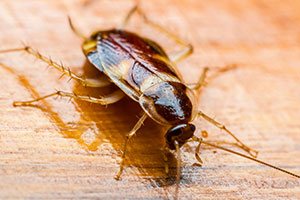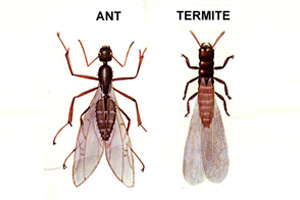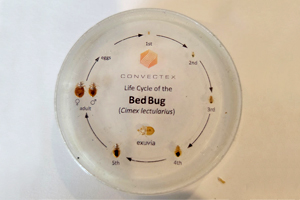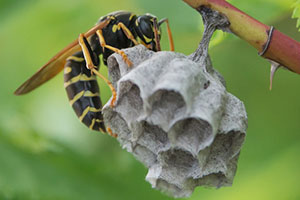Pest ID

Rodents
Damage
Rats and mice consume and contaminate food. They also gnaw on electrical wires and wooden structures, and tear insulation in walls and ceilings for nesting. Rodents can also transmit disease to humans, pets, and livestock. They have been found to transmit typhus, leptospirosis, trichinosis, and salmonellosis.
Detection and Treatment
The presence of mice and rats is usually detected by the damage they cause to food and structures, by their droppings, and by their nests. Since mice are small, they can gain entry into homes more easily than rats. Treatment involves eliminating all entry points and population reduction by the application of rodenticides and traps.

Cockroaches
Damage
Cockroach infestations can be frustrating, as cockroaches are known to carry disease and can trigger allergies, but can also be difficult to eliminate. Cockroaches spread human diseases by depositing disease organisms on food and utensils. The American cockroach, which comes into contact with human excrement in sewers or with pet droppings, may transmit bacteria that cause Salmonella and Shigella. German cockroaches are believed to be capable of transmitting disease-causing organisms such as Staphylococcus, hepatitis, and coliform bacteria. They also have been implicated in the spread of typhoid and dysentery.
Recent studies have found a strong association between the presence of cockroaches and increases in the severity of asthma symptoms in individuals who are sensitive to cockroach allergens, especially children.
Detection and Treatment
Cockroaches may become pests in homes, restaurants, hospitals, warehouses, offices, and virtually any structure that has food preparation or storage areas. These pests are common even in the cleanest of crowded urban areas and older dwellings. Cockroaches feed on a variety of substances, including items that are not considered food such as grease, glue, soap, hair, and toothpaste. It's usually not difficult to discover an infestation, because they are often visible. Treatment usually involves treating cracks and crevices, keeping food and trash areas clean, and the professional application of insecticide and bait on a monthly basis.

Ants
Damage
Ants cause various types of damage, depending upon the variety. Carpenter ants tunnel through wood, destroying structures. Pharaoh ants may transmit serious diseases. A fire ant's sting is potentially deadly to susceptible individuals, and all ants contaminate the food they infest.
Detection and Treatment
Ants build massive colonies, so their presence is generally detected when you see their nests or the ants themselves. Treatments involve baiting, insecticide, and sealing off entry to buildings.

Termites
The termite species that is indigenous to Maryland is the Eastern Subterranean Termite (Reticulitermes flavipes). As its name implies, it lives beneath the soil. Termites, like ants and bees, are social insects and live in colonies. The termite colony is comprised of several castes including a queen, soldiers, winged reproductives (swarmers) and workers. The winged reproductives, or swarmers, are the form most commonly seen by homeowners. Ant colonies also release winged reproductives (flying ants). Many times termite infestations go unchecked when a homeowner mistakes termite swarmers for flying ants.
While termite swarmers are a nuisance, they do not cause damage. Their sole function is to find a mate and begin a new colony. The "worker" caste makes up the bulk of the termite colony and is the only individual in the colony that forages for food and is directly responsible for causing damage to wood and cellulose containing materials. They have no eyes or wings and are soft-bodied, whitish in color and approximately 1/4 inch in length.
The soldiers also have no eyes or wings. They do, however, have enlarged jaws called mandibles which they use to defend the termite colony. They are otherwise similar in appearance to the workers of the colony, whitish in color but their head is enlarged and sometimes brown in color.
Termites are different from almost all other insects in that they can convert the cellulose in wood products back into sugar and utilize it as a food source. In nature, termites are beneficial as they help convert dead wood and other materials containing cellulose into humus. Some other types of insects, such as powder post beetles and old house borers, eat wood but cannot convert the cellulose to sugar. They receive nourishment from the sugars and starch which the tree stored during its growth. Still other insects, such as carpenter ants and carpenter bees, get no food whatever from the wood but simply excavate holes and cavities in the wood to provide protective shelter.
Termite or Ant
There are a number of differences between flying ants and termites. Please read "Termites and Ants" by Maryland's Department of Agriculture, and view the image below.


Bed Bugs
Bed Bug Detection
Bed bugs are elusive and usually nocturnal (peak activity usually occurs between 10:00 p.m. – 6:00 a.m.), which can make their detection difficult. They often lodge in dark crevices, and the tiny adhesive eggs can be nestled by the hundreds in fabric seams. Aside from bite symptoms, signs include fecal spots (small dark sand-like droppings that occur in patches around and especially beneath nests), blood smears on sheets (fecal spots that are re-wetted will smear like fresh blood), and the presence of their empty molted exoskeletons.
Although bed bugs can be found singly, they tend to congregate once established. Although they are strictly parasitic, they spend only a tiny fraction of their life cycles physically attached to their hosts. Once feeding is complete, a bed bug will relocate to a place close to a known host, commonly in or near beds or couches in clusters of adults, juveniles, and eggs which entomologists call harborage areas or simply harborages to which the insect will return after future feedings by following chemical trails. These places can vary greatly in format, including luggage, inside of vehicles, within furniture, amongst bedside clutter, even inside electrical sockets and nearby laptop computers. Bed bugs may also nest near animals that have nested within a dwelling, such as bats, birds, or rodents.
Bed Bug Feeding Habits
Bed bugs are bloodsucking insects. Most species feed on humans only when other prey are unavailable. They obtain all the additional moisture they need from water vapor in the surrounding air. Bed bugs are attracted to their hosts primarily by carbon dioxide, secondarily by warmth, and also by certain chemicals.

Their bites are not usually noticed at the time. They develop slowly to low itchy welts that may take weeks to go away. They prefer exposed skin, preferably the face, neck and arms of a sleeping individual. The neck and jaw line are particularly favored places to feed.
Although under certain cool conditions adult bed bugs can live for as long as 18 months without feeding, under typically warm conditions they will try to feed at five to ten day intervals. Younger instars cannot survive nearly as long, though even the vulnerable newly hatched first instars can survive for weeks without taking a blood meal.

Biting & Stinging Pests
Damage
Bees, wasps, and scorpions are dangerous because of their painful and potentially harmful stings.
Detection and Treatment
Wasp nests and bee hives can be removed by professionals with protective gear. Insecticides are also used. Scorpion problems are usually treated chemically.

Spiders
Except for poisonous spiders, such as the black widow and the brown recluse, spiders are not harmful to humans.
Detection and Treatment
When it's important to control spiders, chemical control is used, along with the destruction of webs and eggs. Since they feed on insects, measures that control unwanted insects will also reduce spider populations.